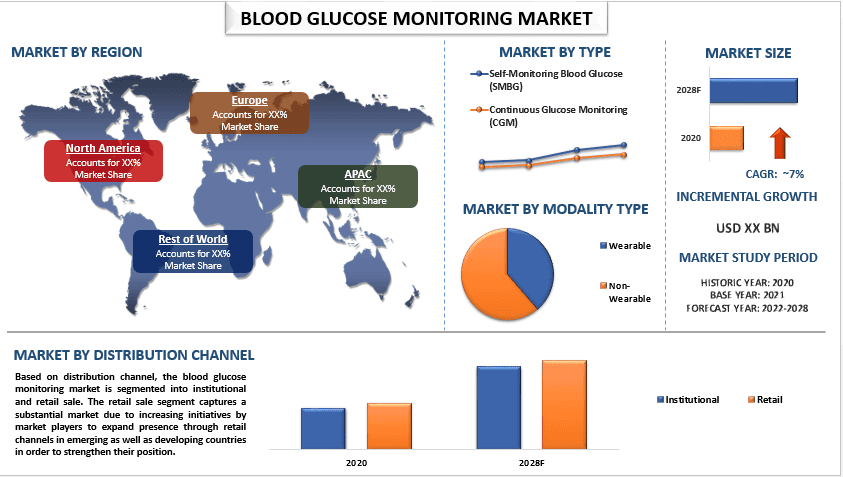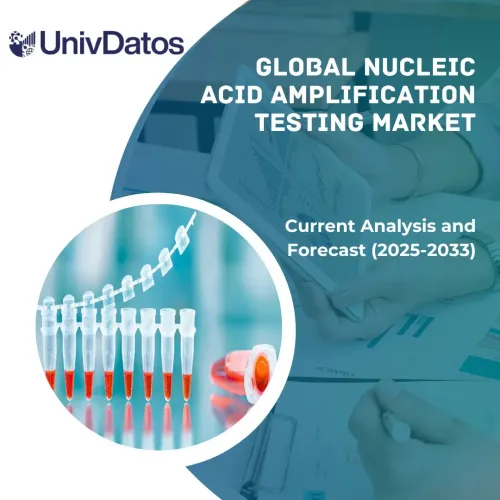- Home
- About Us
- Industry
- Services
- Reading
- Contact Us
Blood Glucose Monitoring Market: Current Analysis and Forecast (2022-2028)
Emphasis on Product Type (Self-Monitoring Blood Glucose (SMBG) and Continuous Glucose Monitoring (CGM)); Modality Type (Wearable and Non-Wearable); Distribution Channel (Institutional and Retail)); and Region/Country

The global Blood Glucose Monitoring Market is expected to grow at a CAGR of around 7% during the forecast period. Blood glucose monitoring involves measuring and logging blood glucose levels, analyzing the information, and sharing it with care providers who provide personalized support to cope with the disease. Blood glucose monitoring observes patterns in the fluctuation of blood glucose (sugar) levels that occur in response to diet, exercise, medications, and or pathological processes associated with blood glucose fluctuations such as diabetes. The adoption of these systems is growing at a faster pace owing to factors such as the increasing patient pool living with diabetes, rising awareness regarding blood sugar monitoring among patients, and the introduction of monitoring devices by the market players. For Instance, a UK-based company has introduced a new discovery in the realm of continuous glucose monitoring. The company has developed the world’s first multi-sensor non-invasive continuous glucose monitor (CGM), heralding a new era of needle-free monitoring for people with diabetes.
Abbott; B. Braun SE; DexCom, Inc.; Ascensia Diabetes Care Holdings AG; Medtronic plc; F. Hoffmann-La Roche Ltd.; Terumo Corporation; LifeScan IP Holdings, LLC; Senseonics; OMRON Corporation are some of the key players in the market. Several M&As along with partnerships have been undertaken by these players to facilitate customers with hi-tech and innovative products/technologies.
Insights Presented in the Report
“Amongst product type, continuous glucose monitoring category to witness higher CAGR during the forecast period”
Based on product type, the blood glucose monitoring market is segmented into self-monitoring blood glucose (SMBG) and continuous glucose monitoring (CGM). Continuous glucose monitoring is anticipated to register higher growth during the forecasted period. The significant growth of this segment is attributed to the increasing adoption of CGMs in developed and emerging countries due to their ability to monitor the patient’s blood glucose level regularly, technological advancement, and new products launched by the market players. For instance, In December 2022, FDA cleared the next-generation Dexcom G7 Continuous Glucose Monitoring (CGM) System for people with all types of diabetes ages two years and older.
“Amongst modality type, the wearable to hold a significant share in the market during the forecast period”
Based on modality, the blood glucose monitoring market is segmented into wearable and non-wearable segments. The non-wearable segment stood at dominating position in the market and is likely to register a higher growth rate during the forecasted period due to painless procedure & easy application, advanced technology, and the presence of a large number of market players with robust portfolios of non-wearable devices. For instance, in 2020, Samsung showcased a noninvasive method for blood glucose monitoring in partnership with experts from the Massachusetts Institute of Technology (MIT).
Amongst distribution channel, the retail channel held a significant share in the market in 2020”
Based on the distribution channel, the blood glucose monitoring market is segmented into institutional and retail. The retail sale segment captured a substantial market share in 2020 due to increasing initiatives by market players to expand their presence through retail channels in emerging as well as developing countries in order to strengthen their position. In March 2021, OMRON Healthcare India has outlined its plans to expand its retail presence in South India to strengthen the availability and practice of home healthcare monitoring.
Blood Glucose Monitoring Market Report Coverage

“North America to hold a significant share in the market”
In 2020, North America held the largest share of the blood glucose monitoring market, due to the large patient pool, well-established healthcare facilities, new product launches, and wide acceptance of advanced technologies. According to International Diabetes Federation (IDF), 51 million adults (20-79) are living with diabetes in the North America and Caribbean Region in 2021. This figure is estimated to increase to 57 million by 2030 and 63 million by 2045. For instance, in November 2021 FDA cleared the POGO Automatic Blood Glucose Monitoring System a new type of blood sugar monitoring system is now available in the United States that allows users to test with a single button-push instead of finger-sticking or inserting test strips into a meter.
Reasons to buy this report:
- The study includes market sizing and forecasting analysis validated by authenticated key industry experts.
- The report presents a quick review of overall industry performance at one glance.
- The report covers an in-depth analysis of prominent industry peers with a primary focus on key business financials, product portfolio, expansion strategies, and recent developments.
- Detailed examination of drivers, restraints, key trends, and opportunities prevailing in the industry.
- The study comprehensively covers the market across different segments.
- Deep dive regional level analysis of the industry.
Customization Options:
The global blood glucose monitoring market can further be customized as per the requirement or any other market segment. Besides this, UMI understands that you may have your own business needs, hence feel free to connect with us to get a report that completely suits your requirements.
Table of Content
Research Methodology for the Blood Glucose Monitoring Market Analysis (2022-2028)
Analyzing the historical market, estimating the current market, and forecasting the future market of the global blood glucose monitoring market were the three major steps undertaken to create and analyze the adoption of blood glucose monitoring in major regions globally. Exhaustive secondary research was conducted to collect the historical market numbers and estimate the current market size. Secondly, to validate these insights, numerous findings and assumptions were taken into consideration. Moreover, exhaustive primary interviews were also conducted, with industry experts across the value chain of the global blood glucose monitoring market. Post assumption and validation of market numbers through primary interviews, we employed a top-down/bottom-up approach to forecasting the complete market size. Thereafter, market breakdown and data triangulation methods were adopted to estimate and analyze the market size of segments and sub-segments of the industry pertains to. Detailed methodology is explained below:
Analysis of Historical Market Size
Step 1: In-Depth Study of Secondary Sources:
Detail secondary study was conducted to obtain the historical market size of blood glucose monitoring through company internal sources such as annual reports & financial statements, performance presentations, press releases, etc., and external sources including journals, news & articles, government publications, competitor publications, sector reports, third-party database, and other credible publications.
Step 2: Market Segmentation:
After obtaining the historical market size of the blood glucose monitoring market, we conducted a detailed secondary analysis to gather historical market insights and share for different segments & sub-segments for major regions. Major segments are included in the report as product type, modality, and distribution channel. Further country-level analyses were conducted to evaluate the overall adoption of testing models in that region.
Step 3: Factor Analysis:
After acquiring the historical market size of different segments and sub-segments, we conducted a detailed factor analysis to estimate the current market size of the all-terrain vehicle market. Further, we conducted factor analysis using dependent and independent variables such as product type, modality, and distribution channel of blood glucose monitoring. A thorough analysis was conducted for demand and supply-side scenarios considering top partnerships, mergers and acquisitions, business expansion, and product launches in the blood glucose monitoring market sector across the globe.
Current Market Size Estimate & Forecast
Current Market Sizing: Based on actionable insights from the above 3 steps, we arrived at the current market size, key players in the global blood glucose monitoring market, and market shares of the segments. All the required percentage shares split, and market breakdowns were determined using the above-mentioned secondary approach and were verified through primary interviews.
Estimation & Forecasting: For market estimation and forecast, weights were assigned to different factors including drivers & trends, restraints, and opportunities available for the stakeholders. After analyzing these factors, relevant forecasting techniques i.e., the top-down/bottom-up approach were applied to arrive at the market forecast for 2028 for different segments and sub-segments across the major markets globally. The research methodology adopted to estimate the market size encompasses:
- The industry’s market size, in terms of revenue (USD) and the adoption rate of the blood glucose monitoring market across the major markets domestically
- All percentage shares, splits, and breakdowns of market segments and sub-segments
- Key players in the global blood glucose monitoring market in terms of products offered. Also, the growth strategies adopted by these players to compete in the fast-growing market
Market Size and Share Validation
Primary Research: In-depth interviews were conducted with the Key Opinion Leaders (KOLs) including Top Level Executives (CXO/VPs, Sales Head, Marketing Head, Operational Head, Regional Head, Country Head, etc.) across major regions. Primary research findings were then summarized, and statistical analysis was performed to prove the stated hypothesis. Inputs from primary research were consolidated with secondary findings, hence turning information into actionable insights.
Split of Primary Participants in Different Regions

Market Engineering
The data triangulation technique was employed to complete the overall market estimation and to arrive at precise statistical numbers for each segment and sub-segment of the global blood glucose monitoring market. Data was split into several segments & sub-segments post studying various parameters and trends in the areas of product type, modality, and distribution channel in the global blood glucose monitoring market.
The main objective of the Blood Glucose Monitoring Market Study
The current & future market trends of the global blood glucose monitoring market were pinpointed in the study. Investors can gain strategic insights to base their discretion for investments on the qualitative and quantitative analysis performed in the study. Current and future market trends determined the overall attractiveness of the market at a regional level, providing a platform for the industrial participant to exploit the untapped market to benefit from a first-mover advantage. Other quantitative goals of the studies include:
- Analyze the current and forecast market size of the blood glucose monitoring market in terms of value (USD). Also, analyze the current and forecast market size of different segments and sub-segments
- Segments in the study include areas of product type, modality, and distribution channel
- Define and analysis of the regulatory framework for the blood glucose monitoring industry
- Analyze the value chain involved with the presence of various intermediaries, along with analyzing customer and competitor behaviors of the industry
- Analyze the current and forecast market size of the blood glucose monitoring market for the major region
- Major countries of regions studied in the report include Asia Pacific, Europe, North America, and the Rest of the World
- Company profiles of the all-terrain vehicle market and the growth strategies adopted by the market players to sustain in the fast-growing market
Deep dive regional level analysis of the industry
Related Reports
Customers who bought this item also bought










